Did you know that both cold water and tropical fish species are highly susceptible to temperature shock, and they won’t thrive if the water in their environment is too warm or cool for their needs? A high-quality aquarium heater should keep your tank temperature constant and stable, but how can you monitor the water temperature quickly and easily?
To do that, you need the best aquarium thermometer that you can buy. And that’s where we can help. Check out this guide to the best digital aquarium thermometers that are available on the market today, as well as essential need-to-know information on how to use them.
Quick Comparisons of the 6 Best Aquarium Thermometers
| IMAGE | BRAND | DETAILS | |
|---|---|---|---|
 | Marina Floating Thermometer |
| View Product |
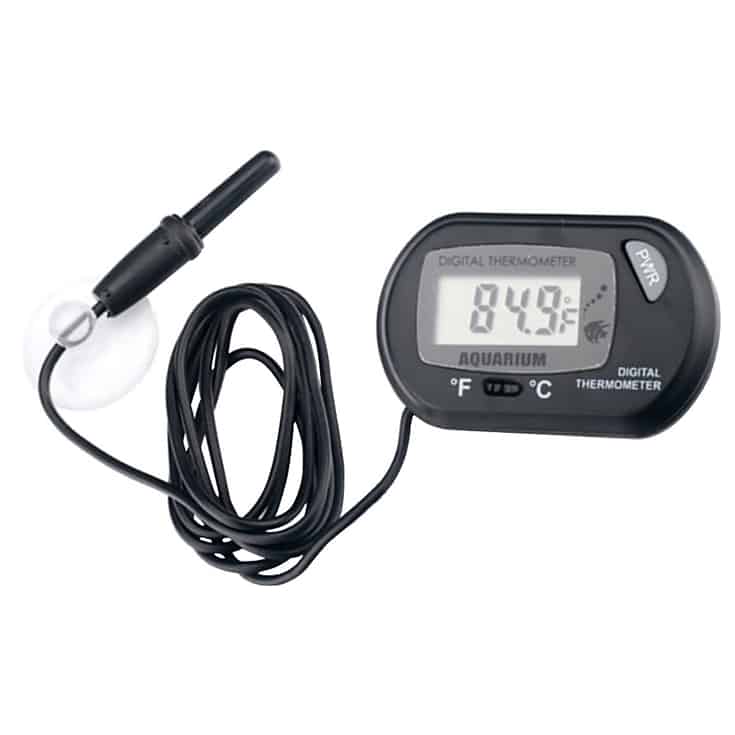 | HDE Aquarium Thermometer |
| View Product |
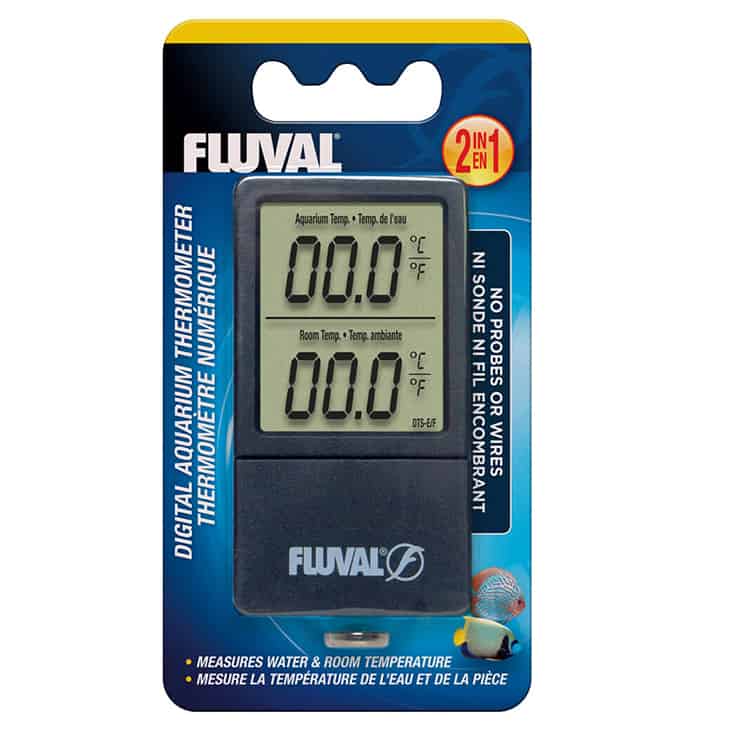 | Fluval Wireless Thermometer |
| View Product |
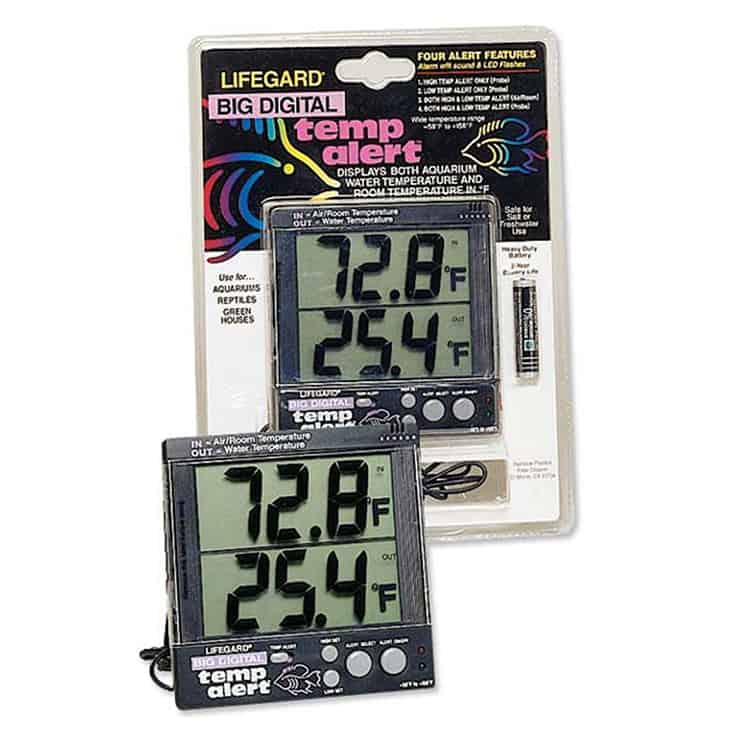 | Lifegard Temperature Alert |
| View Product |
 | Zacro Aquarium Thermometer |
| View Product |
 | Cooper Atkins Waterproof Part |
| View Product |
What Is Temperature Shock In Fish?

Temperature shock happens when the tank temperature suddenly falls too low or becomes too high for the fish species that you keep and remains undetected. Shocked fish become stressed, and many even die, so you can see that monitoring the water temperature in your aquarium is crucial.
Cold Temperature Shock Symptoms
If the water temperature suddenly drops too much, your fish will become unusually lethargic. Fish are cold-blooded creatures that cannot generate their own body heat, absorbing the warmth that they need from their environment. When the water is too cold, the fish stop moving and are unable to swim, often laying immobile on the substrate and eventually becoming comatose.
Treat cold water shock by gradually adding warm water to the tank and replace or reset your heater as soon as possible.
Hot Temperature Shock Symptoms
Hot temperature shock happens when the water temperature becomes too warm, usually because your heater has malfunctioned.
Symptoms to look for include:

- Breathing rapidly at the surface of the water. That’s because warm water cannot hold as much oxygen as cooler water, so the fish begin to suffocate.
- Hanging at the surface. Just below the water surface is a small pocket of highly oxygenated water, so the fish will try to stay close to the surface where there is more oxygen.
- Swimming erratically: If the water is too warm, some fish species begin swimming erratically and more quickly than usual. Excess levels of energy cause stress, which weakens the fishes’ immune system, leading to health problems.
Fix the problem by gradually adding cooler water to the tank until the temperature reaches the correct level. Make sure that your heater setting has not been accidentally changed or replace the heater if you think it may be faulty.
What Is An Aquarium Thermometer And How Does It Work?
All fish species have a specific range of water temperatures that they prefer, and if you keep tropical fish, you’ll need a heater to warm the water to that temperature. An aquarium thermometer is a device that reads the water temperature inside the tank.
There are two types of thermometers that are commonly used to measure water temperature; liquid thermometers and electronic thermometers.
Liquid Thermometers
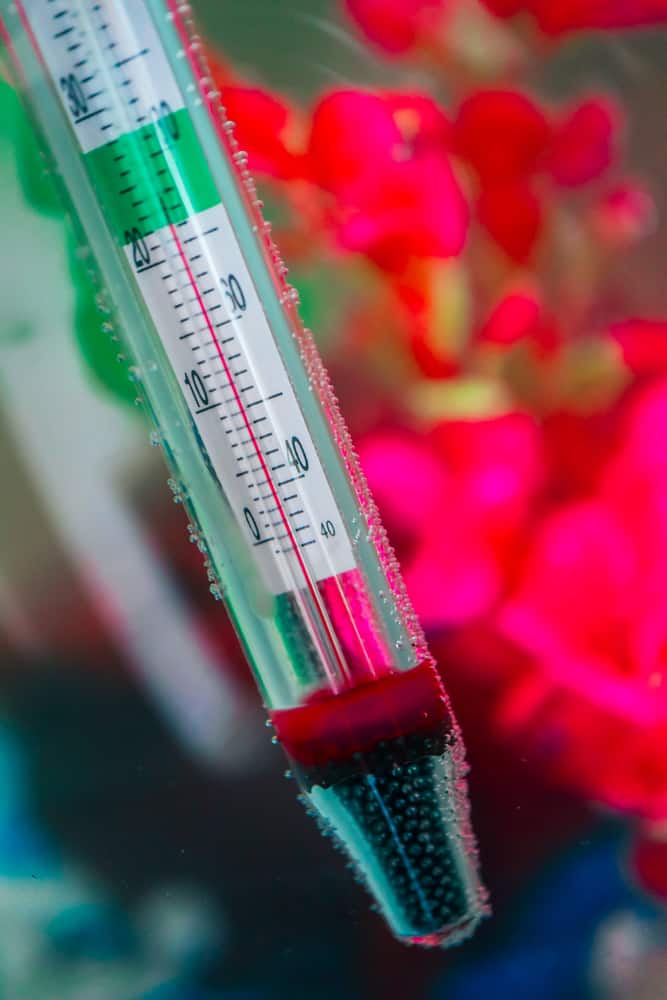
Liquid thermometers consist of glass or plastic tubes that contain a liquid such as alcohol or mercury. The liquid sits in a bulb at the bottom of the thermometer. The tube is set against a backboard that is marked out in degrees Fahrenheit or Celsius. As the temperature surrounding the thermometer rises, the liquid expands and rises up the tube. Conversely, when the temperature falls, so does the liquid inside the tube.
To determine the temperature inside the fish tank, simply find the level of the liquid and read the number of degrees on the scale.
Electric Thermometers
Electric thermometers or probes work on the premise that the ease with which electricity flows through metal alters in line with changes in temperature. So, as the metal warms up, the atoms inside it vibrate, making it more difficult for electricity to flow, so the resistance inside the metal increases. Similarly, as the temperature drops and the metal cools, the electrons are able to move more freely, and the resistance drops.
An electronic thermometer sends a voltage across a metal probe and measures the amount of current that’s passing through the probe. If the aquarium water is warm, the heat creates resistance inside the metal probe. The degree of resistance is measured precisely and converted into a measurement of temperature that is displayed digitally.
What Are The Different Types Of Aquarium Thermometers?
There are three main types of aquarium thermometers, and each has its own variants with their own advantages and disadvantages. Different sizes and styles of fish tanks are best suited to different styles of thermometers.
Digital Thermometer And Probe

Digital thermometers have a probe that you sit inside your fish tank either temporarily or permanently. The probe connects to a digital display unit on the outside of the tank. Some digital thermometers connect wirelessly, while others have a cord that attaches the probe to the display. This kind of aquarium thermometer typically uses batteries to operate. However, you can find more expensive models that are mains powered.
Although digital thermometers are usually the most accurate of the styles available, they do have a few downsides:
- The probe usually attaches directly to the display and that’s rather unsightly.
- Some models have both the display and sensor inside the aquarium, presenting a risk to your fish if the batteries leak.
- Cheaper models tend to have shorter probe cords, which could be an issue for you if you have a large tank.
On the plus side, some digital thermometers have an audible alert feature that activates when the water temperature falls out of your preset range. This type of aquarium thermometer is pretty much unbreakable and not impacted by the ambient temperature of your room.
Also, you can move the probe to any area of the tank, enabling you to check that the water temperature is consistent throughout the setup. Finally, digital thermometers are usually easier to read than other styles.
Submersible Aquarium Thermometer
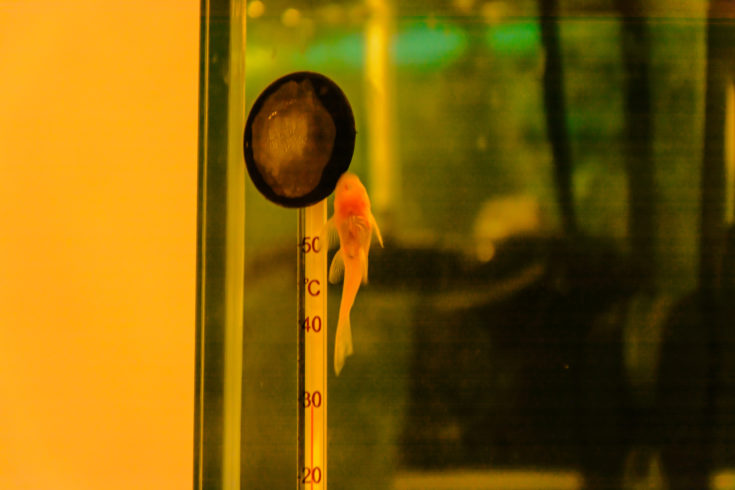
As the name suggests, submersible aquarium thermometers are placed inside the tank. Some styles attach to the side of the aquarium via a suction cup, others hang on the inside of the tank with a clip, some varieties float in the water, and some are weighted so that they sink to the bottom of the aquarium and stand on the substrate.
Submersible aquarium thermometers have several downsides:
- The main problem with submersible thermometers is that the majority are made from glass, making them more fragile than other styles, which can be a problem with particularly boisterous fish.
- The temperature scale on submersible thermometers is often in small print, making them difficult to read. However, most have a brightly colored “safe zone” so that you can make a quick visual temperature check whenever you want to.
- The main drawback to submersibles is that they are not as accurate as digital thermometers.
You can place submersible thermometers wherever you want, and they are easy to move to different parts of your tank too. If you have a very large aquarium, it’s a good idea to use multiple thermometers so that you can get an overall picture of the temperature and identify any cold or hotspots.
Thermometer Sticker Strips
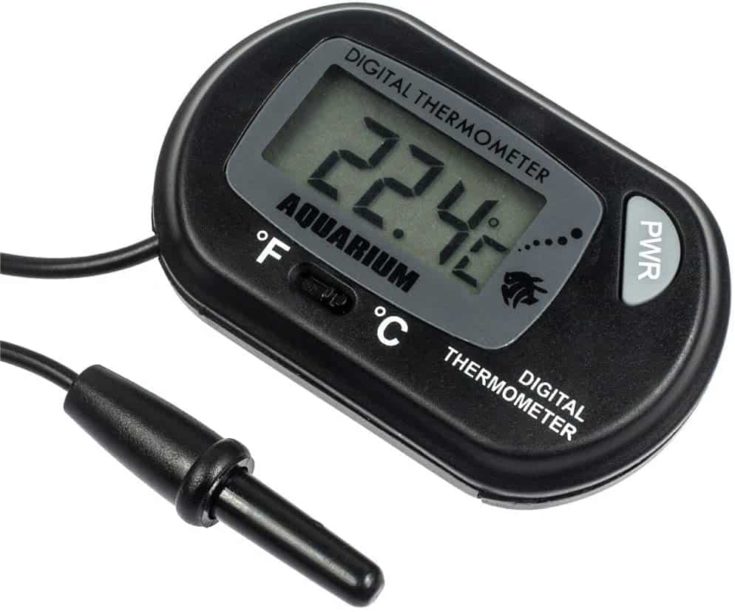
Stick-on thermometers or LCD thermometers are often included in aquarium starter packs and are probably the most widely used in home fish tanks. The temperature is displayed digitally, so they are pretty easy to read, although these are not true digital thermometers.
LCD thermometers are reasonably accurate and are the cheapest option. Most have Celsius and Fahrenheit scales, although the temperature range does vary between models. This style of a thermometer is designed to be stuck to the outside of the tank rather than in the water.
The main issue with LCD thermometers is that they are not very accurate. The air temperature in the room and the thickness of the acrylic or glass between the thermometer and the tank water can affect the reading. Also, you need to be sure that you don’t put the thermometer in direct sunlight or close to cooling or heating sources. You must also not put the thermometer below the level of the substrate as the minimal water flow through the gravel will make the temperature reading inaccurate.
Where Do You Place A Thermometer In An Aquarium?
The water in your aquarium should be heated to an even temperature throughout the tank. You don’t want cold or hotspots that could affect plant growth and cause stress to sensitive fish species. The best way to achieve that is by placing your heater next to your filter pump outlet. That will ensure that the heat is circulated around all parts of the tank.

In a small to medium-sized aquarium, you should place one thermometer at the far end of the tank, which will show you whether the temperature is correct at the farthest point from the heater. In very large tanks, it’s a good idea to use several thermometers situated at different points around the tank.
Wherever you place your thermometer, you need to be able to read it easily. Therefore, the best place to put the thermometer is toward the front of the tank or on one of the sidewalls, as long as you have unobstructed access to it.
What Temperature Should My Fish Tank Be?
Pet fish can be broadly divided into tropical and coldwater species.
Tropical fish species are those that prefer to live in temperatures above 68° Fahrenheit year-round. Temperate species are also referred to as coldwater fish and need temperatures that are typically between 50° to 68°Fahrenheit year-round.
Most aquarium heaters are calibrated to a preset range of between 68° and 86°, and aquarium thermometers will reflect that on their scales.
Benefits Of Using An Aquarium Thermometer
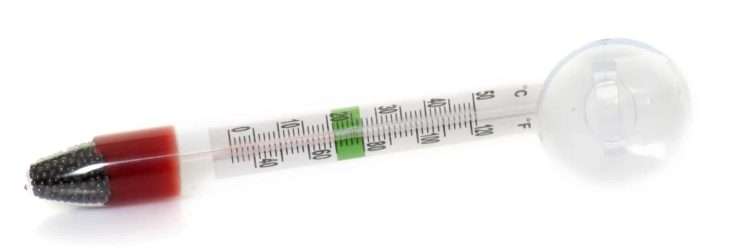
The primary benefit of using an aquarium thermometer is that you’re able to measure the water temperature inside your aquarium. You can monitor the water temperature at different times of the day and in different parts of the aquarium, double-checking that your heater is working efficiently and that the temperature is consistent throughout the environment.
Important Features To Consider
The aquarium thermometer that you choose should have a few important features, including:
Thermometer Type
As mentioned previously, there are three primary types of aquarium thermometers; submersible, stick-on, and electronic/digital. The kind of thermometer that you choose will depend on the size of your tank, the species of fish you keep, and your own personal preference.
Accuracy
A good quality aquarium thermometer should be accurate to within +/-2o Fahrenheit. Thermometers with an accuracy lower than that are not suitable for fish species that have very precise temperature requirements. However, you should be aware that many models are not as accurate as they claim, and it is worth checking the accuracy of your aquarium thermometer with a properly calibrated digital device.
Durability
Although you will pay more for a high-quality aquarium thermometer, it will be more durable and longer-lasting, than cheaper devices. That’s crucial if you buy a liquid thermometer, as your fish will suffer if the device leaks or shatters.
Power Options

If you choose a digital aquarium thermometer, you’ll need to buy a few spare batteries to keep on hand in case of failure. Alternatively, you could keep a spare liquid-filled or stick-on thermometer that doesn’t need a power source.
Ease Of Reading
The easiest types of thermometers to read are LCD stick-on types. For a start, an LCD thermometer is stuck to the outside of the tank, so it won’t get covered in algae. Often, these thermometers have different colored sections too so that you can see at a glance whether the tank water is within the desired parameters.
Who Should Buy An Aquarium Thermometer?
If you keep tropical fish, you need an aquarium thermometer! The correct water temperature is vital to the health of your fish, and although you should be able to trust a high-quality heater, it’s important that you check the temperature regularly just in case the heater develops a fault.
Best Aquarium Thermometer Guide – Quick Product Reviews
Now that you understand the importance of having an aquarium thermometer, you’re ready to choose and buy one for your fish tank. In this section of our guide, we walk you through our six favorite products so that you can pick the one that best suits your needs.
1. Marina Floating Thermometer With Suction Cup

- Liquid
- 30° to 120° Fahrenheit
- Printed backboard temperature display
Water temperature is a critical factor when it comes to the well-being of your fish. So, as well as a reliable heater, you need a thermometer. The Marina Floating thermometer can be left to float freely in the water or you can use the suction cup supplied to fix the device to the wall of your tank.
The thermometer is reasonably accurate and easy to read, as long as you put it at the front of the tank as the print is quite small. The temperature scale is shown in Fahrenheit and Centigrade, and there is a clear safety zone range indicator that’s suitable for most tropical fish species. You can use the thermometer in saltwater or freshwater aquariums.
Just one word of warning; betta fish have been reported as reacting to the bright red bulb at the bottom of the thermometer, flaring, and even attacking the thermometer. So, if you have a betta, you may be better choosing a digital or stick-on style.
| Pros | Cons |
|---|---|
|
|
2. HDE LCD Digital Aquarium Thermometer

- Electronic
- 68° to 80° Fahrenheit
- LCD display
The HDE LCD Digital Aquarium thermometer features a large, easy-to-read LCD display despite its compact size. The thermometer attaches to the outside of the tank by means of the suction cups provided. Submerge the probe into your aquarium water and enjoy accurate, real-time readings that are accurate to 0.1 degrees and are shown in both Celsius and Fahrenheit. The probe can be fixed to the interior wall of the tank with the suction cups provided.
The unit is powered by LR44 batteries that are included so that you can begin using the thermometer right away. Simply press the “On” button, and you’re good to go.
| Pros | Cons |
|---|---|
|
|
3. Fluval Wireless 2in1 Digital Thermometer

- Electronic
- 68° to 80° Fahrenheit
- LCD display
If you want a simple thermometer that’s easy to operate and stays accurate, this offering from Fluval could be what you need. The unit has a big LCD screen that’s super-easy to read even from a distance. A novel feature of the thermometer is that it gives you the water temperature inside the aquarium and the ambient temperature in the room.
The thermometer affixes to the outside of the aquarium glass and couldn’t be simpler to set up. The unit can be used safely with freshwater, saltwater, and brackish tanks and provides a reading within 20° Fahrenheit or 10° Celsius accuracy. You also get a product warranty, which is always nice to have.
| Pros | Cons |
|---|---|
|
|
4. Lifegard Aquatics Big Digital Temperature Alert

- Electronic
- -58°F to 158° Fahrenheit
- LCD display
Lifegard Aquatics Big Digital Temperature Alert aquarium thermometer is not the cheapest out there, but is certainly good value for money and is one of the more accurate devices that you can buy.
The thermometer is designed to fix to the external wall of your tank where it provides both the water temperature and the ambient air temperature of the room in degrees Fahrenheit. The unit has a plastic probe that gives you the water temperature and can be fixed to the inside wall of the tank if desired, using the plastic suction cups provided.
This thermometer has four alert features to alert you via a sound alert or flashing LEDs when the temperature in the tank becomes too high or too low. You can use the thermometer in both freshwater and saltwater tanks.
| Pros | Cons |
|---|---|
|
|
5. Zacro LCD Digital Aquarium Thermometer

- Electronic
- -58°F to 158° Fahrenheit
- LCD display
The Zacro LCD digital aquarium thermometer is a compact unit that is easy to use and offers great value for money.
This is an external thermometer that affixes to the outside of the tank while the probe is placed in the aquarium water. You can safely use the thermometer in freshwater, saltwater, and brackish tanks with just 1 degree of variance in accuracy. The thermometer can be set to show the temperature in Celsius or Fahrenheit, depending on your preference.
Despite the unit’s small size, the display is very clear and easy to read.
| Pros | Cons |
|---|---|
|
|
6. Cooper Atkins DFP450W Digital Pocket Test Waterproof Part

- Electronic
- -40°F to 450° Fahrenheit
- LCD display
Cooper Atkins is a reputable manufacturer of technical tools, temperature, and humidity measuring equipment, including this digital pocket thermometer. This thermometer is actually a replacement part for a larger piece of kit, but it’s an extremely handy item to have in your arsenal of fishkeeping supplies.
The tool is handy if you want to check that your permanently fixed thermometer is accurate or make sure that a heater with a built-in thermometer is working correctly. Simply dip the stem of the thermometer into the aquarium to determine the temperature by reading the LCD display. Also, when carrying out water changes, use this gadget to make sure that the water you’re adding to your tank is the same temperature.
| Pros | Cons |
|---|---|
|
|
In Conclusion
Temperature shock is a big killer of pet fish, and many owners are unaware of heater failure until it’s too late for their fish. So, an aquarium thermometer is a vital piece of equipment for all fishkeepers.
Of the thermometers that we’ve reviewed for you in this guide, my personal favorite is the Lifeguard Aquatics Big Digital Temperature Alert aquarium thermometer. I love the clarity of the LCD screen and the fact that the device gives you both the water temperature and the ambient room temperature, too, making this a great choice for a cold water tank in an unheated room. In addition to all the usual features, this thermometer provides you with four alerts if the room or tank temperature becomes too low or too high.
Overall, this thermometer is an excellent addition to your aquarium essentials and comes highly recommended.
